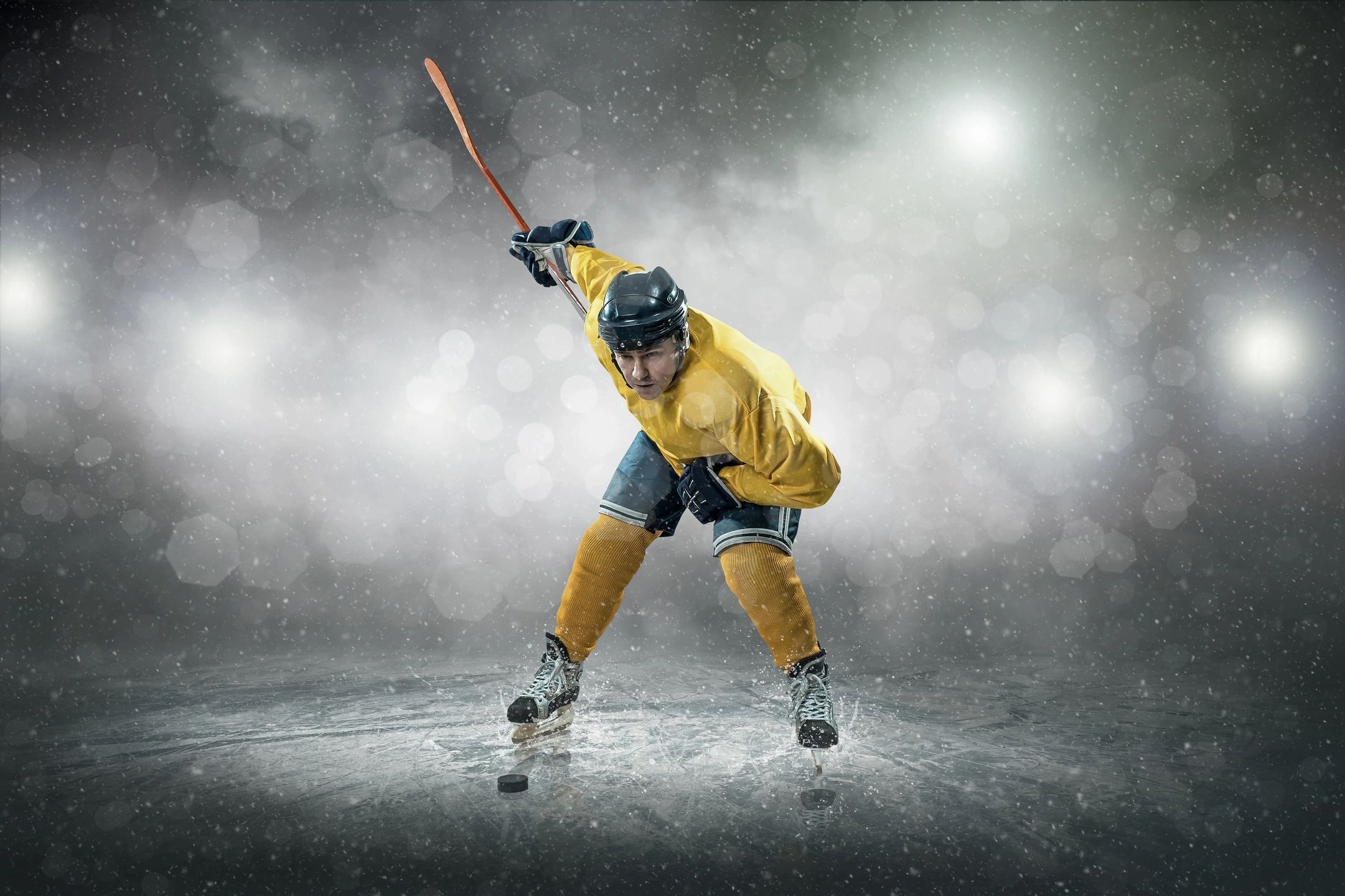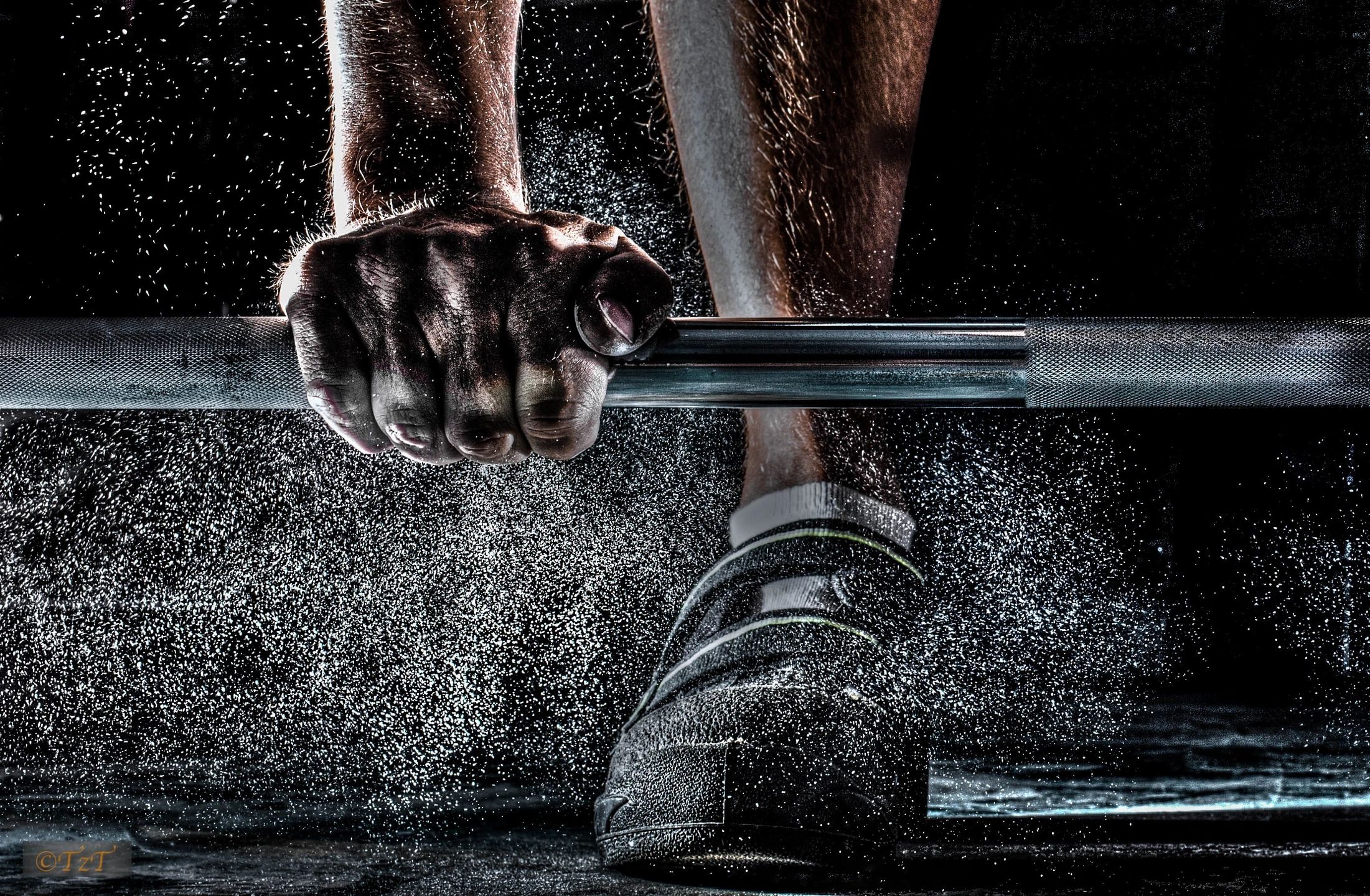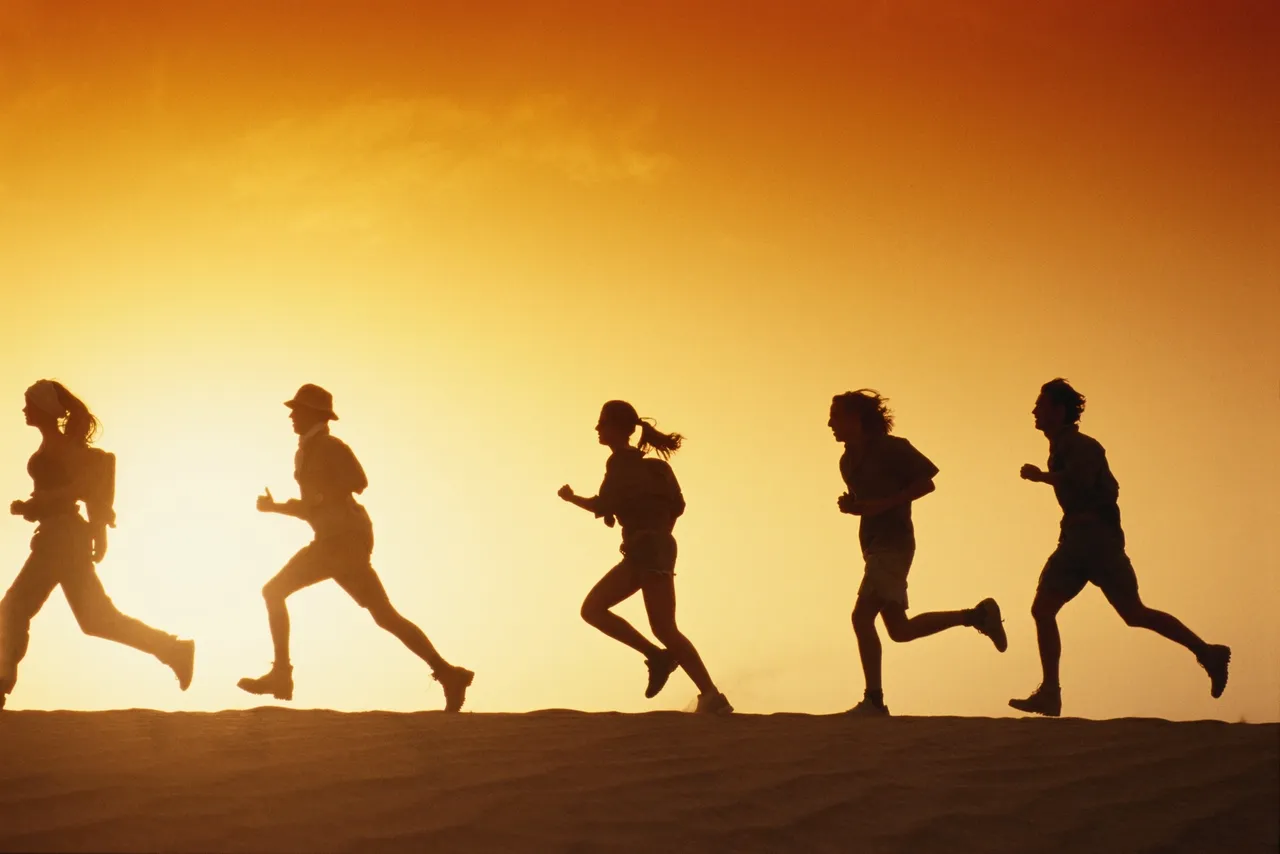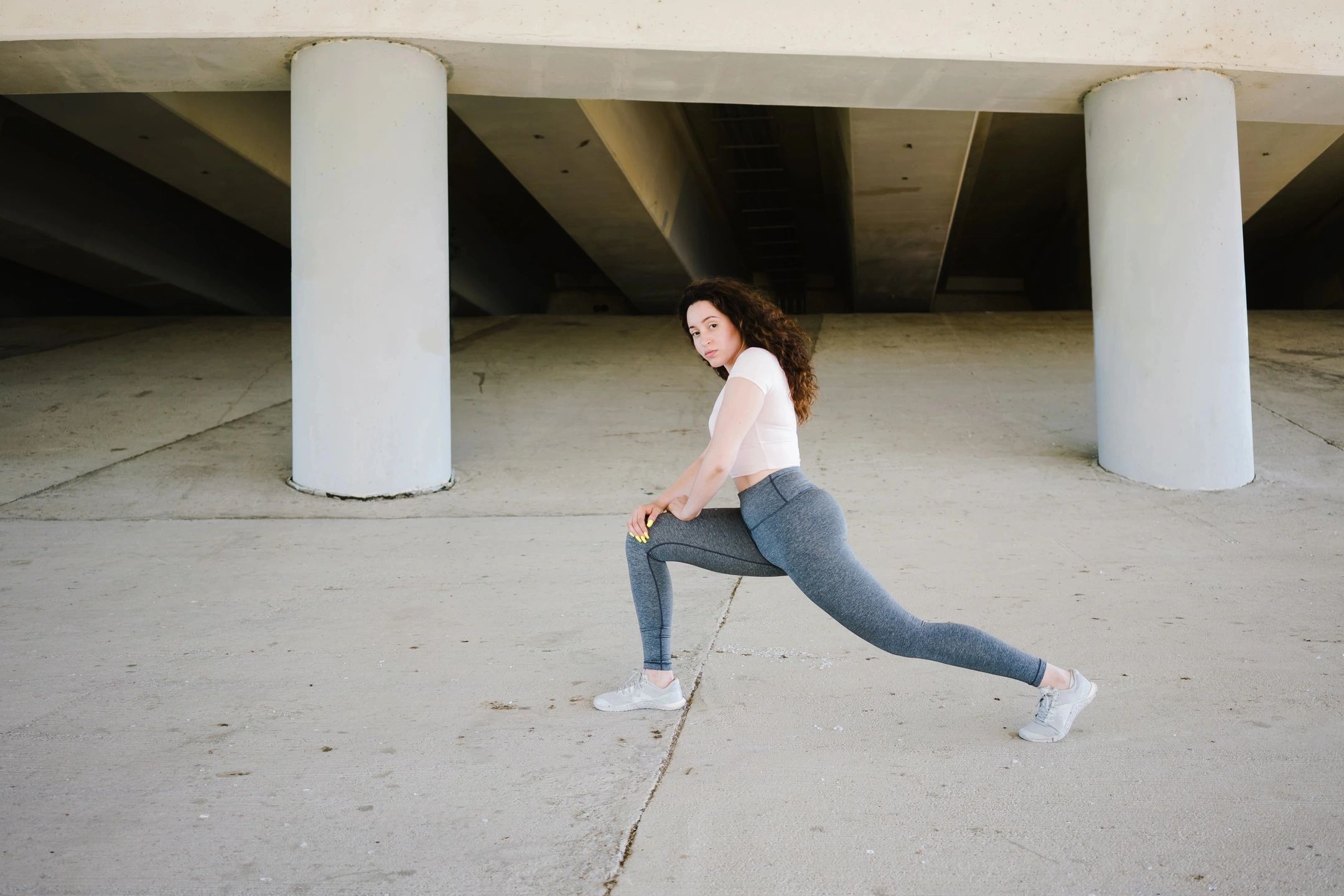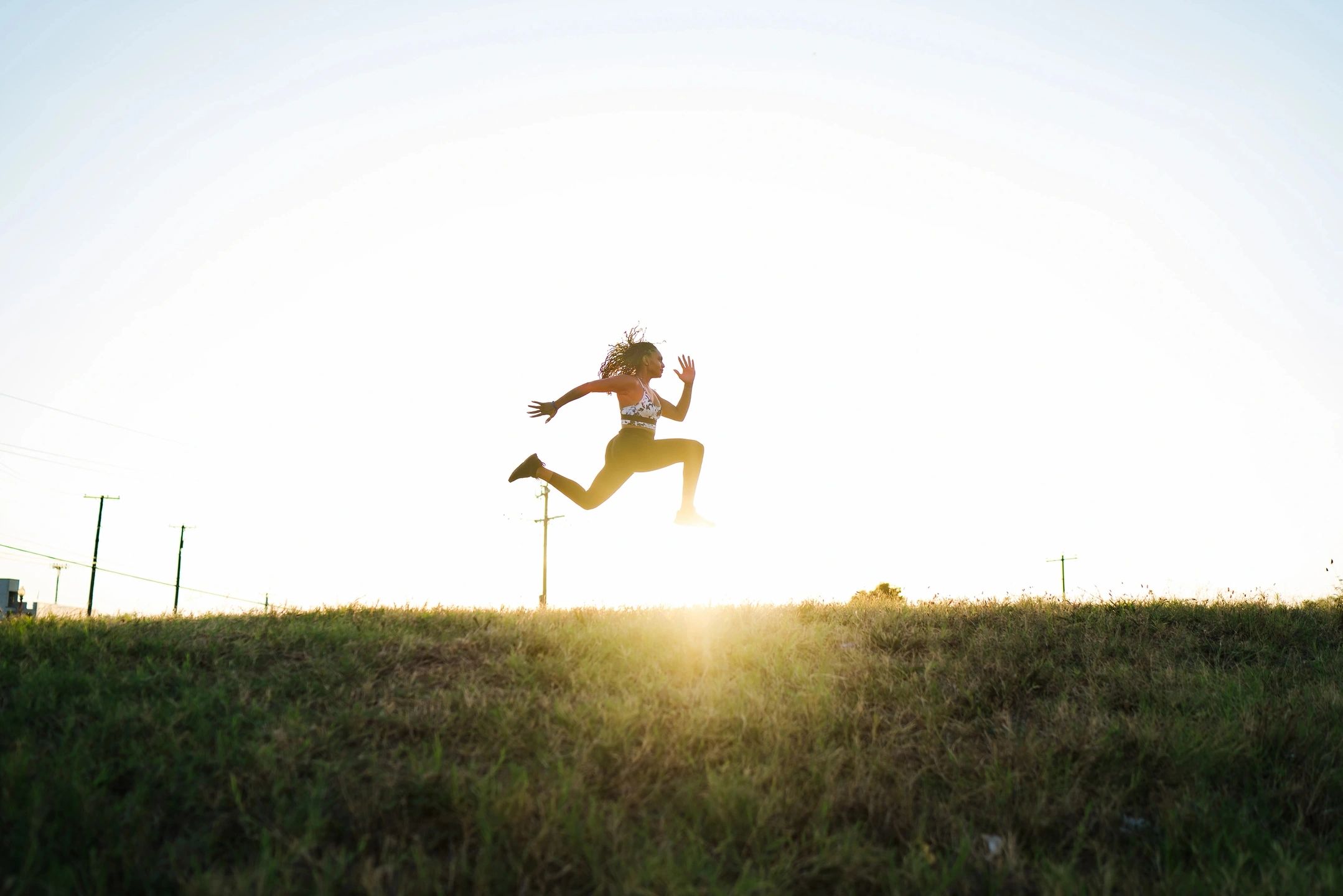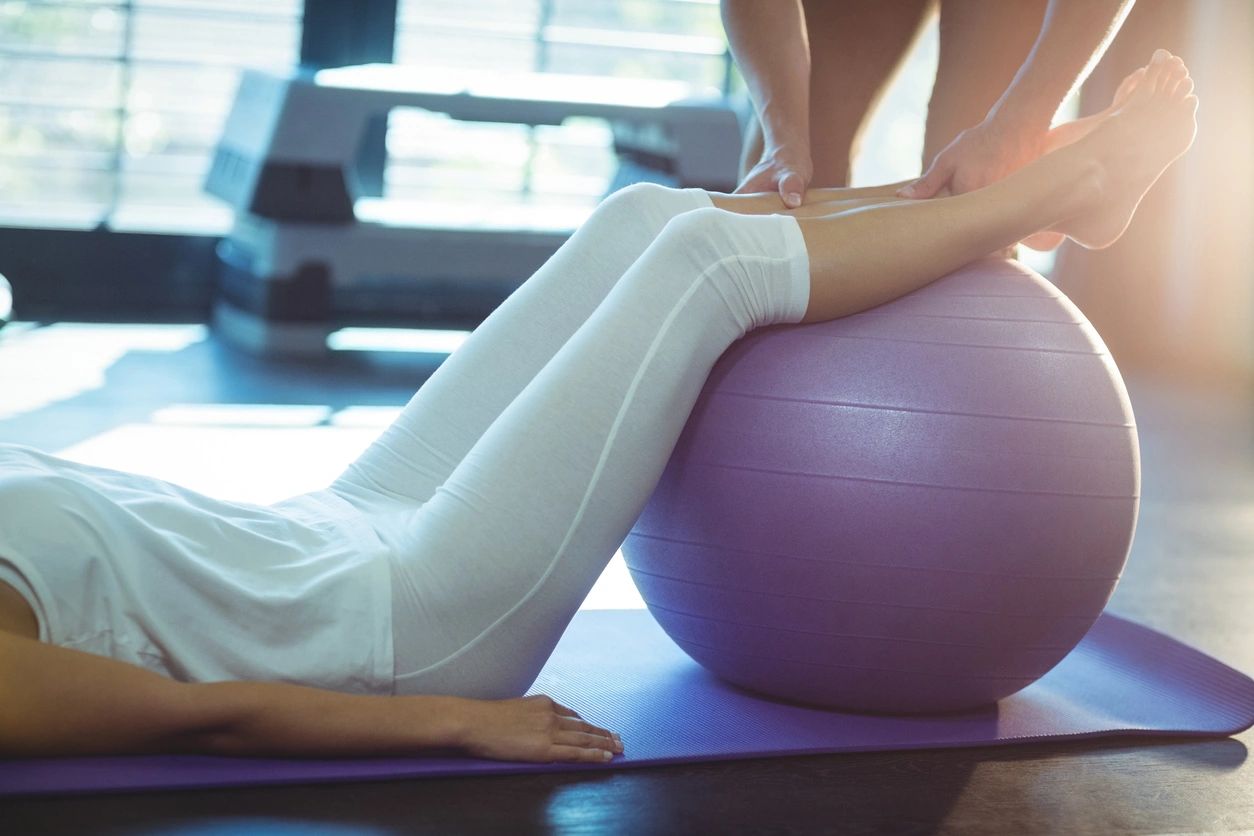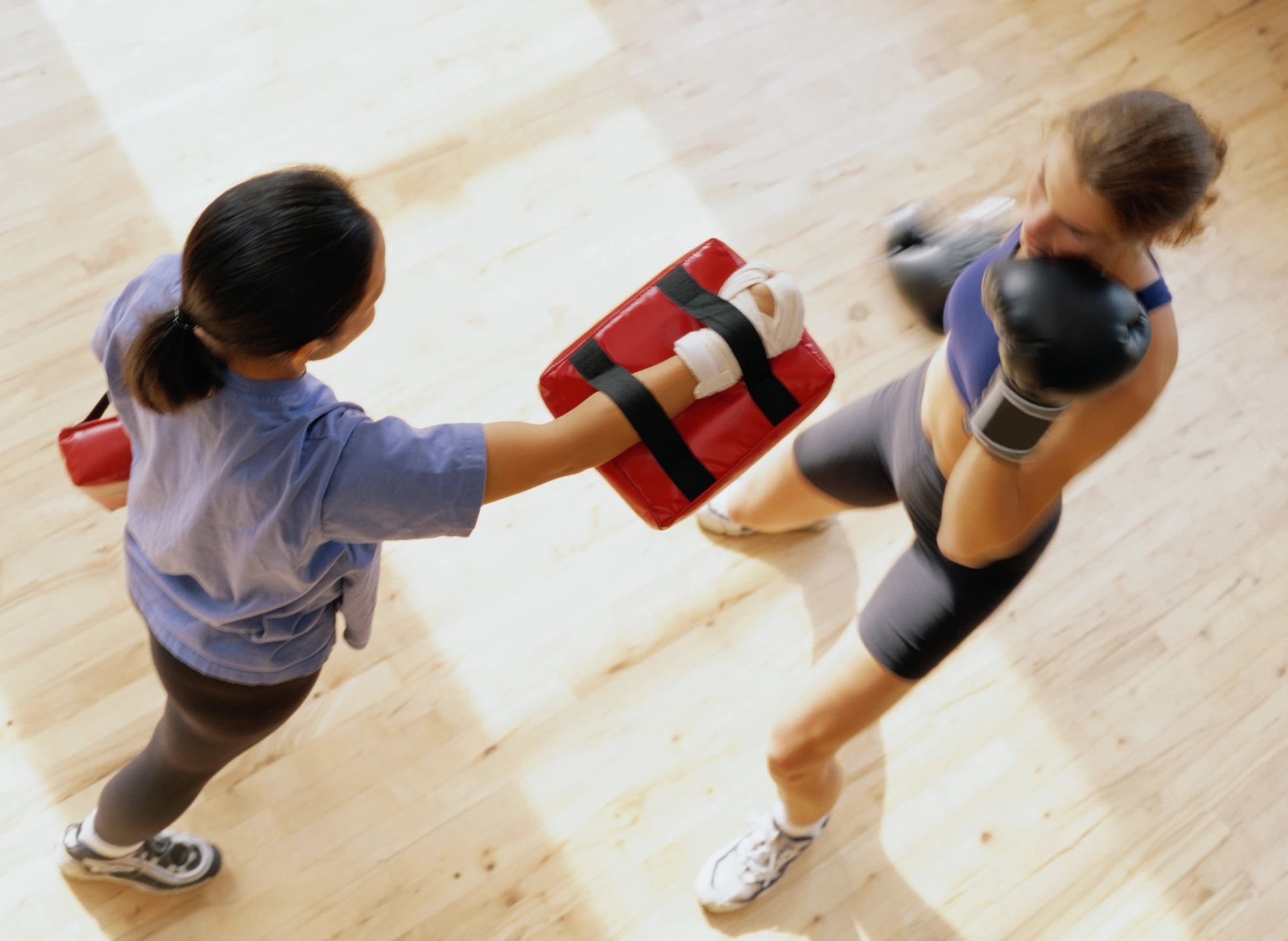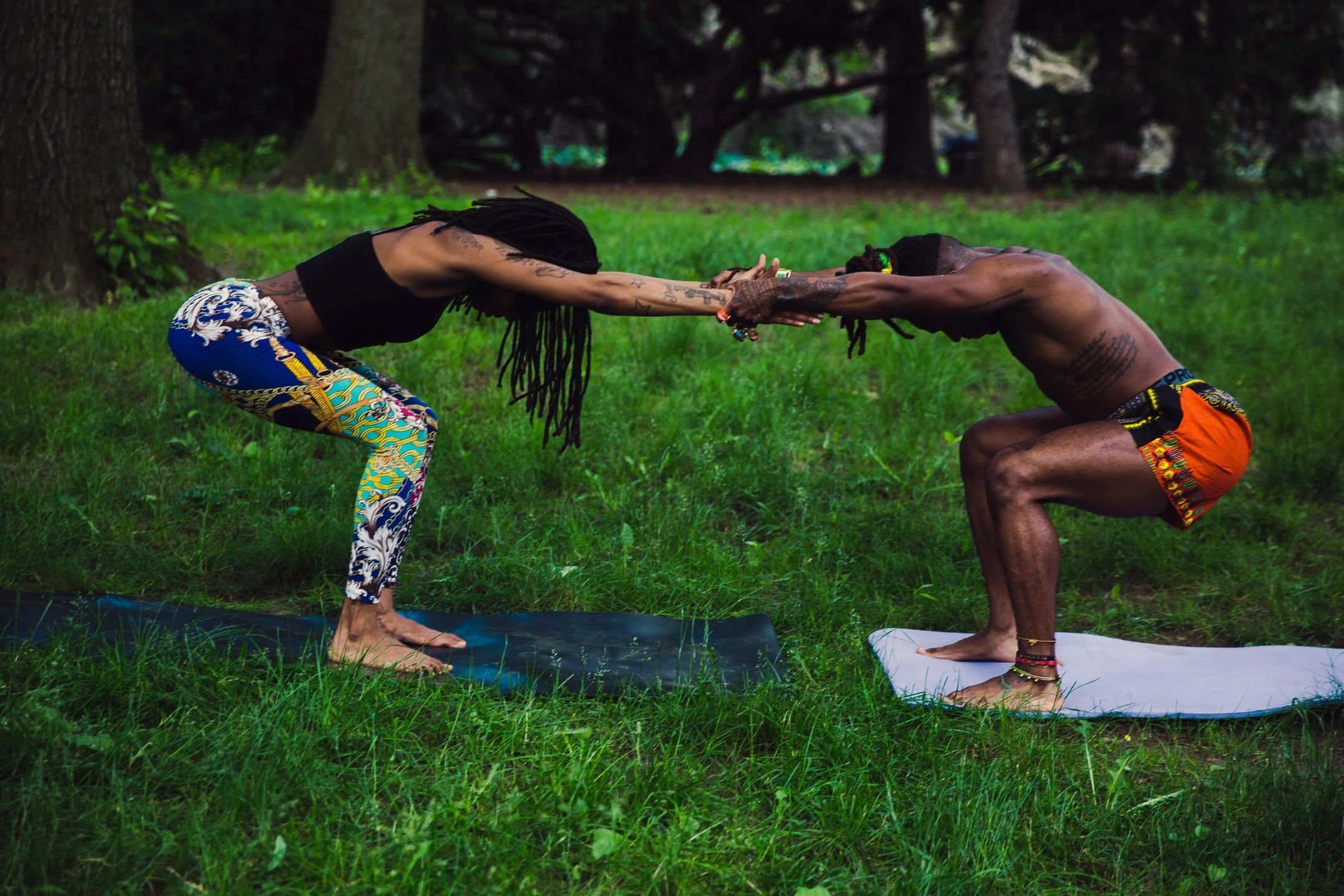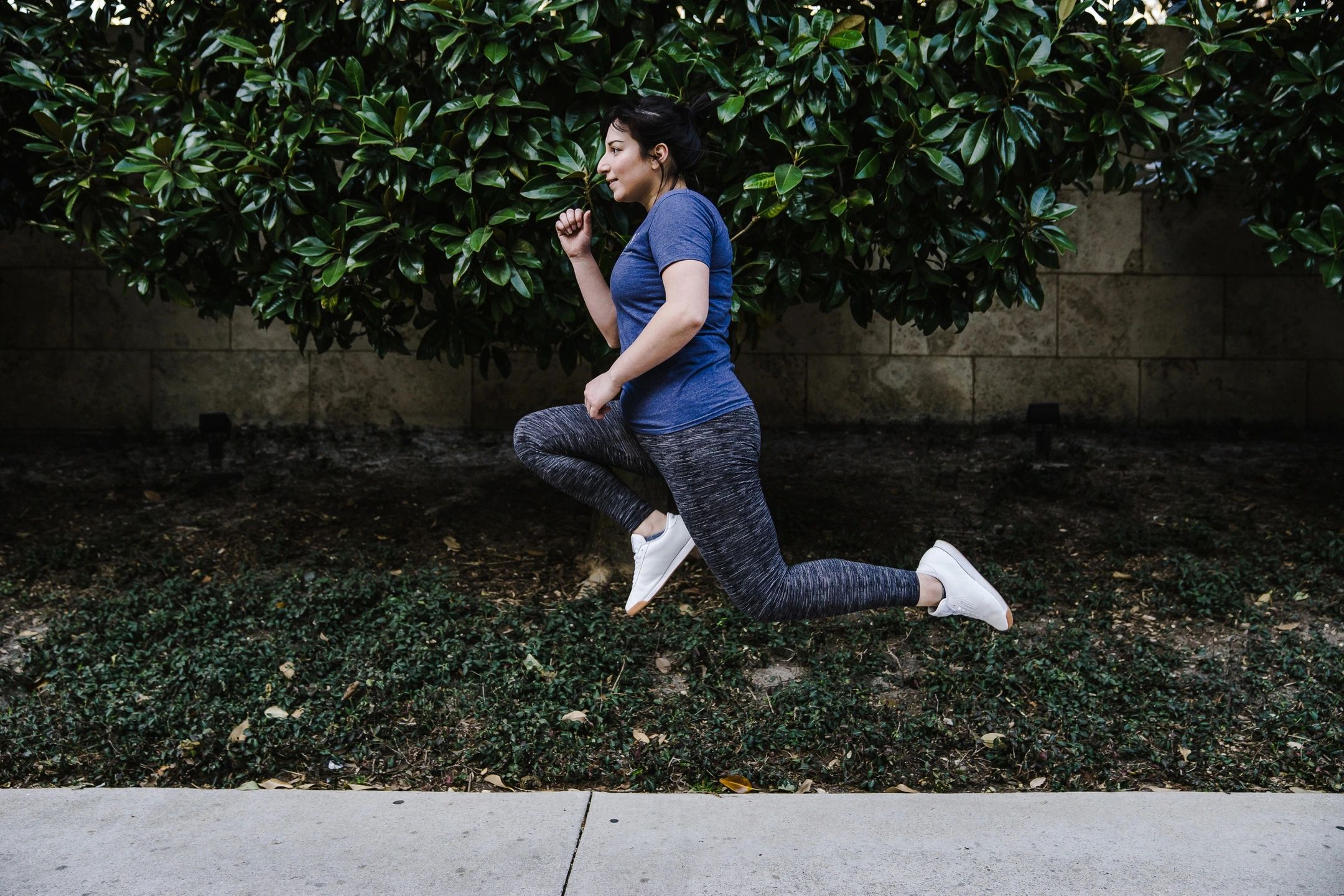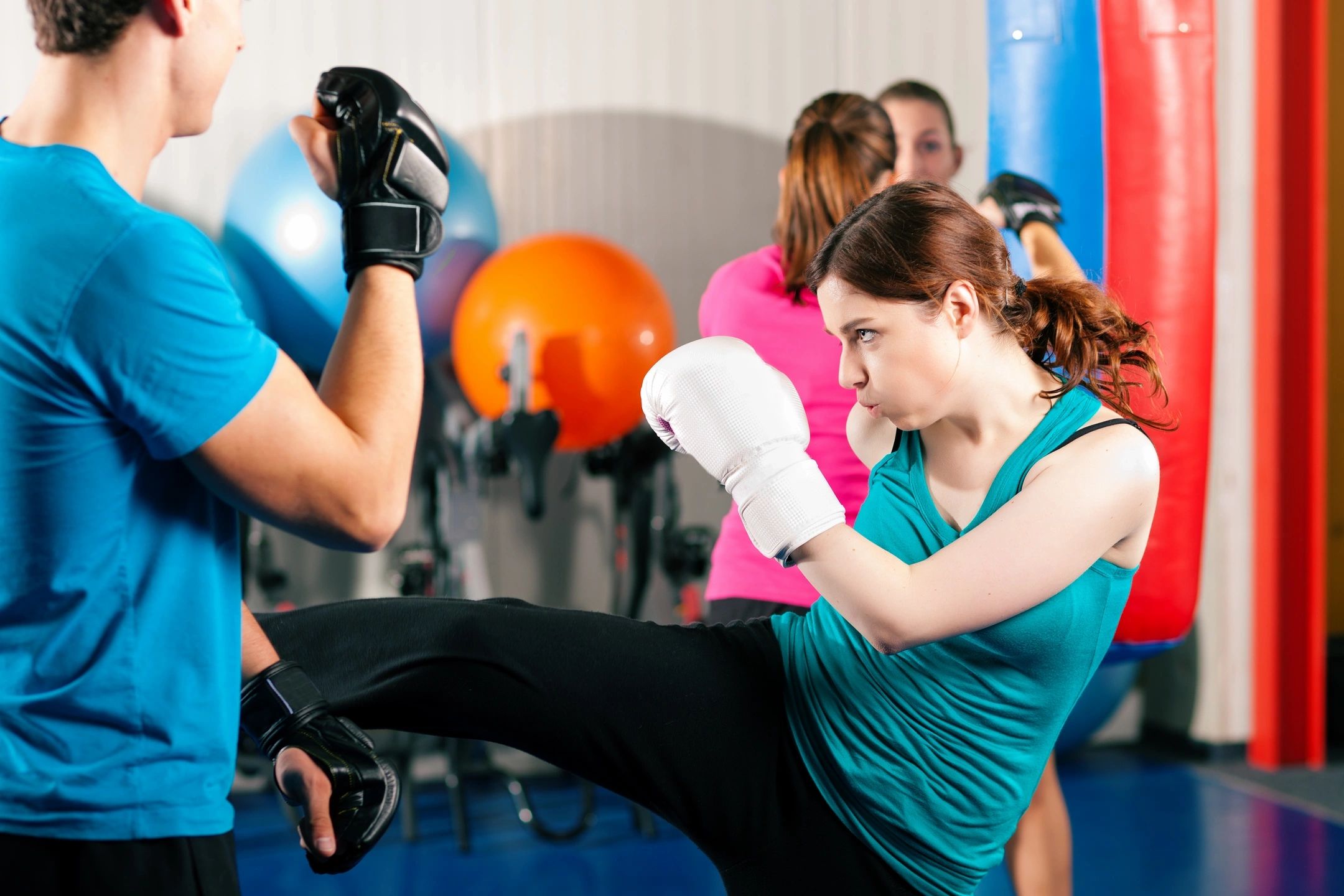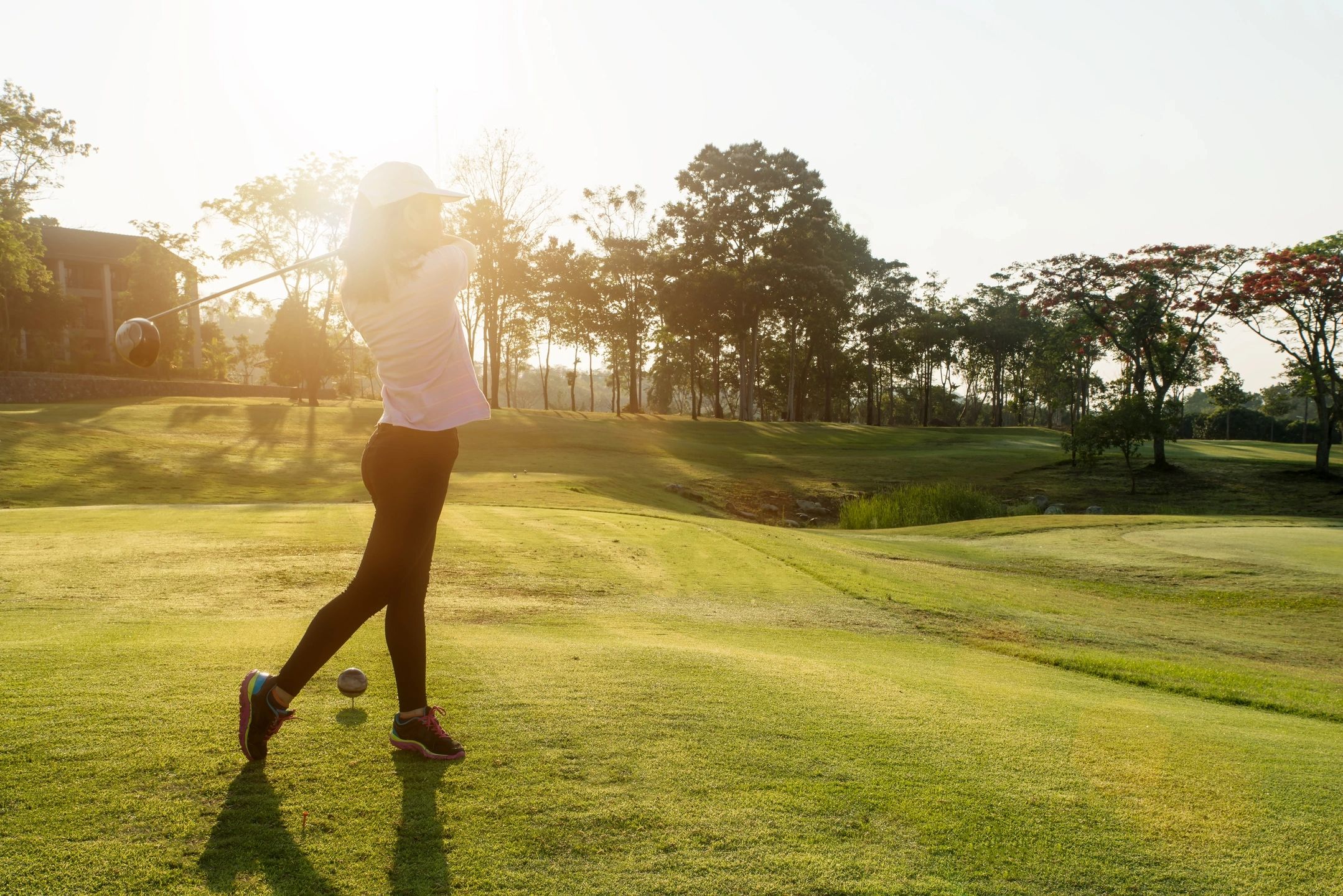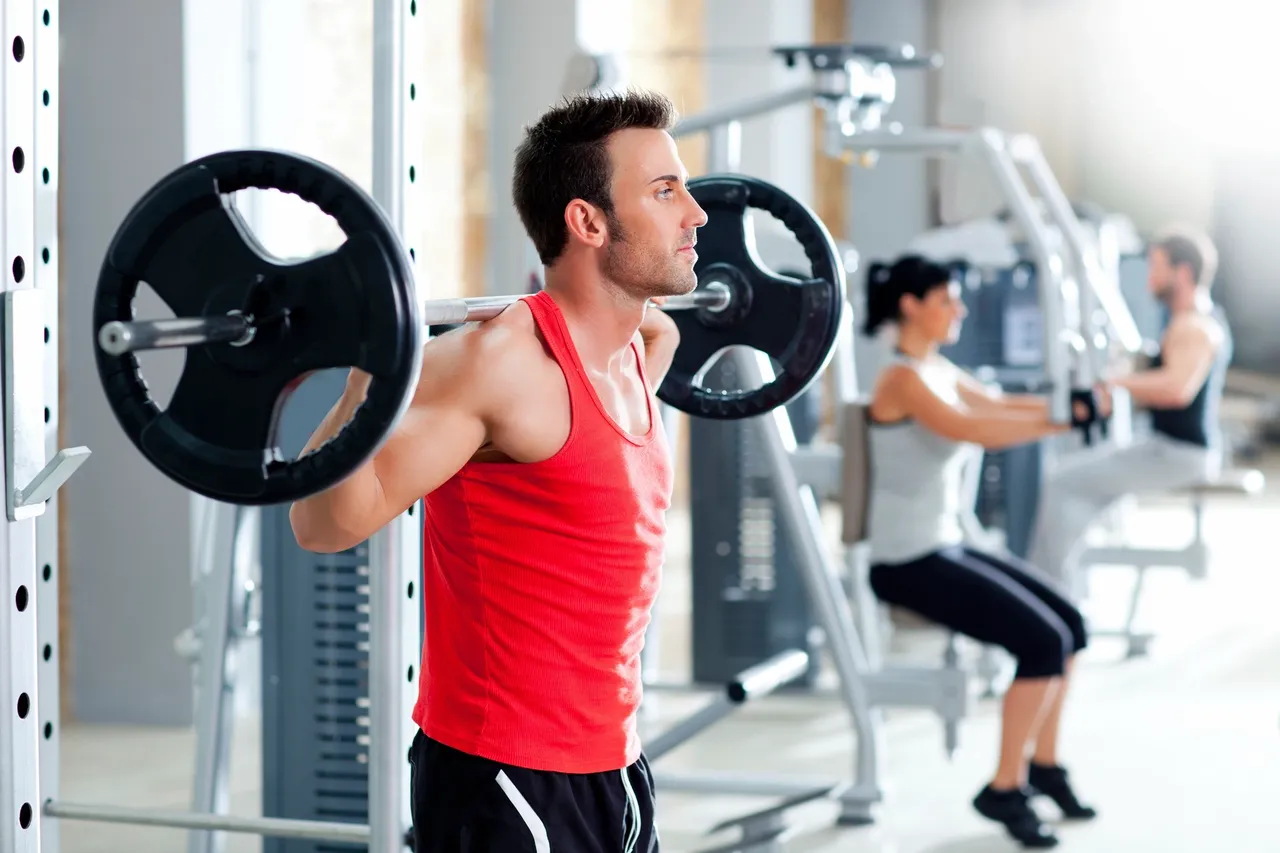-
Isometric knee squeeze: just put a pillow or ball between your knees and squeeze together for 10 seconds at a time. The contraction should not be painful so go easy at first and gradually increase the intensity.
-
Mini side lunges: start in a shoulder-width stance and perform small side lunges. Start easy and shallow and gradually go lower and widen your stance.
-
Adductor leg lifts: lie on the side that was injured. Bring the top leg out of the way by moving it forward or backwards, and you can rest it on a pillow for comfort if needed. Lift the bottom leg upward – this will be a relatively small motion.
-
Normal side lunges: take a stance that’s about 2x shoulder-width. Then perform side lunges, keeping the leg that you’re lunging away from, straight. You will feel a stretch in the adductor muscles of the leg that is straight.
-
Slider side lunges: start in front of a counter or something to hold onto just in case. You’re going to do the same side lunges but with the straight leg sliding outward this time. If you’re on a floor with no carpet, you can do this using a towel under your foot. Whether you’re on carpet or not, you can use a furniture slider under your foot. If you don’t have a furniture slider, any solid piece of plastic works like a plastic plate or frisbee. Go slow and shallow with these at first so you don’t end up doing the splits. Once you can do these normally, start putting more and more weight on the sliding foot, both on the way up and down. This makes this exercise much harder.
-
Reverse side plank: lie on your side on the ground with a normal chair that has a cushion on the seat. Scoot closer/under the chair so that you can put your top leg on the cushion. Start with the chair supporting just above the knee. Now you’ll do a side plank by propping up on your forearm but the bottom leg should not touch the ground. You will be doing a plank only with the adductors of the top leg holding you up. As you get stronger and more comfortable with this, begin to move away from the chair so that it supports your leg lower down. Go to below the knee, then at the calf, then at the foot/ankle.
Category: Sports Performance
Strength programming
-
3×6 (3 sets of 6 reps) @ 70%
-
5×3 @ 85%
-
4×6 @ 65%
-
4×4 @ 80%
-
3×5 @ 75%
-
Test 1RM: 1-3 PR attempts
-
3×6 @ 70%
-
5×3 @ 77.5%
-
4×4 @ 80%
-
3×5 @ 75%
-
5×3 @ 85%
-
4×5 @ 75%
-
3×6 @ 60% (deload before PR)
-
Test 1RM: 1-3 PR attempts
-
3x4x72.5% (lighter workout after 1RM test)
Improving the runs
Want to improve your running? Here are 3 important factors to address: fixing energy leaks, improving cardiovascular fitness, and horizontal force production.
2 of those topics I’ve already covered so I’ll briefly cover them here and also refer you to those articles. You can look them up, or just go to the blog and click on the “Sports performance” section and look them up via the date posted which I’ve included.
Fixing energy leaks
Energy leaks are when your body doesn’t stabilize a segment properly so force isn’t transferred as well as it could have been. The main occurrence of this is every time you land on one leg, the opposite hip drops down too far. Extra energy is then required to pull the hip back up to neutral before you can propel yourself forward. Check out the following posts for more detail:
- Check please!” – posted on 3/5/21
- “How to have acceptable running form” – posted on 8/17/21
Improving cardiovascular fitness
Your cardiovascular fitness with any exercise is determined by 3 things.
- VO2 max: how much oxygen you can take in and deliver to the muscles.
- Lactate threshold: how intensely you can exercise while still primarily burning fat.
- Movement economy: how efficient your body is at whatever movement you’re doing.
Each of these can be specifically targeted, but in general, the more time you invest in your sport, the better all 3 of these things become. There’s a major debate right now on what intensity of training best improves these factors. The 2 biggest contenders are Zone 2 training (essentially training at the ‘talk test’ pace – a pace you can exercise at while still talking without gasping for air) and high intensity interval training. They both improve your cardio significantly and the best scenario is to obviously include both. Read this post for more:
- “Go long!” – posted on 2/6/21
Horizontal force production
Running is a forward movement – therefore any energy that moves you backwards or up and down is wasted. This can occur at the foot, knee, or hip.
Force can be produced while running that actually stops your forward movement. This happens when your front foot lands forward of your center of gravity. Since it’s in front of you, pushing through that leg (which you automatically do to accept weight on it), actually acts as a brake to your momentum. This is a double waste of energy because you both spend energy braking as well as spend energy re-accelerating once your center of gravity is over and past your foot. The solution to this is to make sure your foot is landing underneath your body. This doesn’t require any specific kind of foot strike – you can still land on the heel, mid-foot, or forefoot depending on your natural tendency.
People do this when they think about running as ‘reaching out’ with their front foot. The focus can be shifted to either pushing your body forward or pushing the ground behind you. You can also think of running as falling forward. A final alteration is you can focus on increasing your running cadence (steps/minute) so that you take shorter steps.
Next is energy wasted with too much up and down movement due to excessive knee bending. This is very easily spotted as someone who bounces a lot while running. Generally, cues to focus on pushing the body forward or the ground backwards helps with this as well. Increasing cadence also naturally helps.
Finally, the hip. Your butt muscles, the glutes, make up the biggest muscles in the body and serve to push the body forward. They function best whenever the thigh is in line and slightly behind the torso. So if someone runs by bouncing up and down, their thigh is never getting behind their trunk. If someone is slumped over while running, they also can’t get their leg behind their body. As with the other problems, the cue to push the body forward or push the ground backwards is very helpful. The extra emphasis can now be added that the leg should finish slightly behind the body.
Summary of horizontal force production
- Land with the foot under the body
- Push the body forward or push the ground backwards until your leg is slightly behind you
- Optional: increase your cadence by 5% and assess how that feels and how fast you run compared to your previous cadence
How to have ideal running form
There’s no such thing.
You can have acceptable running form though – see ‘how to have acceptable running form’ post on that.
How to have acceptable running form
There are essentially only 3 actual factors to monitor to decrease your risk of injury while running: be symmetrical, don’t collapse too much, don’t overdo it.
Seriously, comb through running research and injury prevention. A lot of what is being sold to prevent injury or improve performance is not worth your money.
Take a look at any high level race. What you’ll see is there is no ideal running form – you will see runners of all different forms at the highest level of the sport, including overpronators!
Things that people think matter, like pronation/supination and heel/mid-foot/forefoot striking – don’t.
So let’s go through these 3 factors first. Next post, we’ll go over cues for performance, but for now, this post is on injury prevention.
We’ll start with symmetry – the most obvious factor. Your goal is to run, or if you’re working with someone, help them run, symmetrically on each side. This means having relatively the same amount of foot/ankle, knee, hip, and trunk motion. It’s generally easy to spot, especially when you watch someone run from all angles. If you’re by yourself, you can use film yourself from behind, in front, left, and right (on a treadmill is easiest). Correcting asymmetry ranges from very easy (a simple cue) to very hard or impossible (if there’s a structural difference on one side). But generally, the target should be the ankle or the hip, since those are usually the source of asymmetry and the rest of the leg just follows suit. If you’re analyzing yourself and notice an asymmetry and it doesn’t correct with a simple cue on your part, it will be much easier and faster to consult an expert (physical therapist, running coach) than trying to figure it out yourself.
Next, collapsing. Collapsing refers to segments of your leg, not to your whole body. If your entire body collapses when running, you should stop running. And probably go consult a medical expert ASAP. Collapse will mostly happen at 3 points in your leg. The foot/ankle (pronation), the knee (flexion), and the hip (hip drop). Collapse is generally a good thing – it allows your body to absorb shock and then spring back to propel you forward. If you try running stiffly, you’ll feel the shock going through your body with every step. However, collapsing too far is also a problem as this loads the body more to absorb the impact and then requires more energy to reverse the movement. Ideally you want each segment to collapse like a spring – it compresses a little bit and then jumps back into place, requiring no additionally energy.
Overpronation (collapse at the ankle) is demonized in running, but there’s actually nothing wrong with it. In fact, it might even be slightly protective of injury – a finding that only emerged from analyzing a lot of data on a lot of runners. So there are only 2 movement patterns that I am aware of that actually have a sizable amount of evidence that would indicate they are related to pain.
The first is too much knee flexion or bouncing up and down too much when running. Going too far down not only wastes energy (because running is a horizontal motion, not a vertical one) but also puts a lot of strain on the knee. While it would seem like the best advice would be to tell someone to bounce less, better advice is actually to increase your cadence. Cadence is how many steps you take per minute. Taking fewer steps generally means you’re in contact with the ground longer, likely from dipping down more instead of just springing forward. Increasing your cadence means less ground contact time, less dipping down, and less pressure on the knees. Usually increasing cadence by 5% is helpful with this and can be done using a metronome app. Just calculate their cadence in steps/min and then set the metronome to that tempo.
The second movement pattern is a cross-over gait pattern. This is when one foot crosses over the middle. If you were to trace how wide foot placement is when running, it would look like they’re running on a line. This is normal. Abnormal is when one foot frequently crosses that line. Some people will notice that the heel of one foot frequently scuffs their other leg. Interestingly, this problem is generally due to the leg that is not crossing over, but rather the one that is on the ground. What’s happening is that the stance leg’s hip is ‘dropping’ – meaning it is collapsing so that the pelvis doesn’t stay level, but instead drops down on the swing leg’s side. The causes the swing leg to cross the midline, and places a large stretch and load on the outside part of the leg where the IT band is located. Often the IT band is blamed for this pain, though it’s much more likely it’s due to irritation of the nerve in that exact same region called the lateral femoral cutaneous nerve. Either way, strengthening and cues should target the stance leg and keeping the pelvis more level.
And finally, don’t overdo it. This one is also pretty obvious. If you go from running 1 mile, 3 times/week to running 3 miles, 3 times/week – there’s nothing special to developing pain here, you’ve just overloaded your body. This can be prevented by gradually increasing your volume. If you have a race or event in the future, just plan accordingly and give yourself plenty of time to ramp up the volume. If you did overdo, you’ll start by taking some time off. You can get back into running based on how long you had to take off.
- If you took 1-2 weeks off, then start at 75% of your previous volume and take a week or two to get back to your normal routine.
- If you took 2-6 weeks off, take as long as you were out to return. So if you were out 4 weeks, start at 50-75% and gradually bump it over 4 weeks.
- If you were out more than 6 weeks, take twice as long as you were out. This extends up to being out 3-4 months. If you were out longer than that, like 3 years, then just plan on starting over. You can do a ‘couch to 5k’ program or other controlled program to help build volume up.
Maximus your gluteus
If you run, jump, swing a racket/club/bat, or punch or kick – your glutes need to be maximus. When you powerfully shift your weight – your glutes are providing that power. Read on to learn how to squeeze the crap out of your glutes (metaphorically)!
First, when is glute max active? Basically anytime you’re straightening your hip. This can be done without weight bearing like kicking your leg backwards, but obviously in sports (and life in general), it’s mostly done while weight bearing. Straightening the hip in weight bearing is shifting your weight forward which is used with pretty much most standing movement. Additionally, anytime you’re swinging your arm (golf, racket sports, baseball, combat), you generate power in the hips by shifting your weight which once again comes from the glutes.
To activate your glutes, start with a shoulder-width stance and turn your feet slightly outwards. It can help to put your hands on your butt so that your fingers can feel the muscle activating. Now lean very slightly forward, just so that your head is an inch forward. From here, roll your hips/pelvis under like you’re tucking your tail. You will feel your glutes kicking on. Just follow this contraction by squeezing your butt as hard as you can, to the point it almost feels like it will cramp. Hold for a few seconds then relax. That is activating your glutes.
Now, for training. You’ll want to both get your glutes stronger as well as learn to activate them powerfully. To do this, simply perform this glute activation drill at the end of each rep of your standing exercises. After each squat, each deadlift, each kettlebell swing/clean/snatch, after each bridge – squeeze until your glutes feel like they will cramp. At first, it will likely take a few seconds to reach this amount of force because your glutes aren’t used to fully activating. After a few reps though, you will be able to do this very quickly. This will not only strengthen your glutes but teach your body to contract them fully and faster. Warning: this will make your glutes very sore the next day. You’ve been warned…
That can be done with any exercise where the feet are symmetrical. However, it can and should be done with exercises where the feet are asymmetrical as well, such as lunges, step-ups, single leg deadlifts, kickbacks, and so on. Any exercise with a split stance with both feet on the ground, you’ll squeeze the back hip at the top of each rep.
It is crucial to understand that glute max really shines when the leg is behind the midline of the body/trunk. This is important for pretty much all sports movements. Whenever you run or strike something, the back leg needs to be behind the trunk. Many runners bounce up and down which wastes energy as well as loads the knee more. Instead, pushing the body forward or pushing the ground backwards (they accomplish the same thing) with an upright posture and the leg finishing behind the body, will ensure more efficient push-off.
For any striking motion during a sport (golf swing, racket swing, punch, etc.), you can practice squeezing the back leg’s glute. This will not only add power to your weight shift and rotation, but teach your body to make this automatic.
Once you have true mastery of activating your glutes powerfully and quickly, you should then work on pulsing your contraction at the moment just before, and through, impact. A pulse being a strong, but quick squeeze. You’ll want to pulse both your core and your back glute at the same time. Don’t be surprised by the amount of force and snap this adds to your strike!
Sports elbow – pain in the ol’ cranon
One of my workout partners and I were sparring and he complained afterwards of mild elbow pain after he tried to repeatedly uppercut me. He asked me what the cause of this was and how to fix it… A part of me considered explaining that proper uppercut form was to wrench your back while simultaneously hyperextending your knees and jutting your chin forward, but the physical therapist in me prevailed.
Most sports-related elbow pain comes from 2 things.
- Amount of rotation at the elbow: the elbow is caught between the hand and the very mobile shoulder. Most people put their hand in a certain position (palm down, racket facing this way, fist facing upward, etc.) and just let the rest of their arm figure it out. Try this right now. Hug your arm close to your side with your elbow bent and face your palm as far down as you can, like you’ll be typing on a computer. Now lift your arm off your body and see how much further you can rotate your hand. You can also do the opposite: how your arm at to the side and turn your hand palm up as far as you can. Then lower your arm to your side and see how much further you can rotate. This was my “friend’s” problem – he was kindly trying to uppercut me by trying to rotate his fist so that his palm faced towards his body, but when his arm was out to his side, he didn’t have the range of motion. This led to a high amount of torque that the elbow was forced to endure. This problem is also common in any sport where the hands are put in a specific position: golfing, racket sports, rock climbing, and more. The solution then is to avoid maximum rotation at the elbow. This can be accomplished by moving the upper arm closer or away from the body. Yes, this will almost always change the mechanics of your sport’s movement in other ways, but pretty much everyone I’ve worked with on this is able to accommodate the position without much trouble. They also almost always find they perform better because their body is in a more natural position for them and they don’t have pain. So I grudgingly told my friend he could either bring his arm in closer or just punch with his hand in a natural orientation (instead of trying to control what way his palm was directed).
- Overload due to muscular tension: the other main contributor to elbow pain from repetitive strain is overload. In some cases, this can be very obvious. You go from playing tennis or golf 2x/week to playing 5x/week. But often many people find that after reducing their volume, and sometimes even after medical treatment like steroids or physical therapy, their elbow starts hurting again as soon as they ramp their volume back up to a normal playing level. Try this. Pick up a pen as you normally would. Now pick it up again but with as little effort as possible while still securely holding it. Finally, pick it up one last time but use a death grip. Each one of these trials you accomplished the exact same thing, but they each had a different amount of load on the grip muscles (which insert into the elbow). The death grip is what most people use, not only at the point of contact, but often in between hits. All of this adds a tremendous load to the elbow. The solution here is two-fold. First, practice gripping only as hard as necessary (not too hard, not too loose). Second, learn to squeeze only when needed and relax the rest of the time. In tennis, for example, this would mean squeeze the racket as firmly as necessary during your swing but relax your grip before and after shots. It’s often helpful to think about pulsing. Pulsing is when your muscles contract just before and through contact to add that extra whip to your hit. This allows the body to be fluid and relaxed with the windup, then generate a tremendous force on contact, and relaxed again on follow-through.
So there you have it. If you have sports-related elbow pain, try experimenting with arm position to avoid maximum rotation at the elbow/forearm, and practice pulsing on contact and relaxing in between hits to reduce load. There are, of course, things other than repetitive strain injuries that could be causing your elbow pain. Irritation of the ulnar nerve is not uncommon, but you’ll need to see a physical therapist or orthopedic physician for a specific diagnosis based on your presentation.
Lower body exercises
When choosing what to include in your plan, there are a bunch of categories people want to straddle. I’ll go over what I’ve chosen and why.
Static vs. Dynamic
Static movements are ones where you stay relatively in the same space, often with your base planted and unmoving. Examples would be squats, lunges, deadlifts, and cleans. Dynamic movements are where you move around like in sled drags, car pulls, walking lunges, and loaded carries. Static movements tend to build greater limit (absolute) strength while dynamic movements tend to build greater stability and power. For example, the 2 kings of limit strength are squat and deadlift, both statics, while some of the most well known power movements, jumping and sprinting, are dynamics. However, there is a lot of overlap. For example, cleans, snatches, and kettlebell swings are all static movements that build tremendous power; while a car pull or heavy sled drag, both dynamics, build a huge amount of strength. Static exercises are also much more convenient – you can do squats anywhere but you can’t pull a car anywhere. Most gyms you could easily deadlift, even if it’s just with dumbbells or a Smith machine, but you can’t do sandbag carries or other loaded carries due to limited space or equipment.
That being said, I personally prefer dynamics for almost all of my lower body training. The reasons are three-fold. First, I don’t compete in any strength competitions, therefore I don’t have to try to maximize my squat or deadlift for a single rep. If you do, then you absolutely have to train static movements. But since I don’t, I train heavy dynamics that involve a similar static pickup. I do heavy farmers walks which involve a deadlift to start. I also do the yoke carry which involves a squat to start. Both of these are much higher than normal, the farmers walk pickup being essentially a high handle trap bar deadlift and lifting the yoke requiring just a quarter squat. Therefore, the carryover to the full range of motion movement is somewhat limited, but still useful. Second, I find dynamic movements much more useful to real life tasks, more interesting, and more fun. Third, a well-rounded program would have both static and dynamic movements, but I enjoy being a minimalist. Doing heavy dynamic movements will have more carryover to static movements than the reverse.
Movement patterns
Generally, most would classify the 2 main movement patterns of lower body exercises as the squat (knee-dominant) and the hip hinge (hip-dominant). However, this applies more to static movements. Instead, I do loaded carries and resisted locomotion (sled/car work) which I call load-con-motion or LCM. For carries, I use either farmers walk implements, a heavy sandbag, or the yoke. For LCM, I use either a sled or a car. There are many exercises and variations you could do with all that equipment, but I also keep that to just a few variations, covered below.
Intensity and range of motion
The smaller the range of motion (ROM), the more weight you can use. You can squat more with powerlifting style squat vs. Olympic style, just like you can quarter squat more than half squat. While you could do a high intensity lift with a large ROM, like doing a heavy triple with an Olympic style squat, I generally prefer to keep the division clean and just do heavy, smaller ROM exercises and faster, large ROM exercises. For example, with the loaded carry, I do heavy farmers walks. The handles are relatively high, meaning the ROM is small, but I tend to do these heavy. On the other hand, I also do sandbag clean and carry, either in my arms or on 1 shoulder. To clean a sandbag from the ground, you have to go lower than a standard deadlift (greater ROM), so I use much less weight but emphasize power. Sometimes I do mix it up by doing lighter farmers walks for longer distance and heavy sandbag carries, but this is much less frequent. The same goes for my LCM exercises. Since the sled is lighter than the car, I mostly do overhead sled sprints, which have much more leg ROM. They are light, but fast. There are many sled pull variations – I almost exclusively do light overhead sled sprints. On the other end, I do heavy car pulls.
Programming
So all of the above essentially explains my exercise selection. I work out 2 times per week so I vary which dynamic I do from workout to workout, and I generally decide if it’s a heavy grind or a lighter sprint on the day of my workout. Heavy dynamics are incredibly fatiguing on the body, so if you feel fatigued or tired throughout the day, then just listen to your body and switch to at least 2-3 workouts of lighter, faster work. You could plan each workout in advance, but I find that listening to your body helps keep motivation higher since you push less into overtraining. That being said, here are the movements I use:
- Overhead sled sprint: light weight, fast speed
- Car pull using a harness: I mix it up between using a rope assist and no rope
- Sandbag clean and carry: I’ll clean it to chest level and do either bear hug or Zercher (carrying it in the crooks of your elbows) carries or to shoulder height and walk with in on my shoulder
- Farmers walk and yoke carry: these are programmed similarly. Really heavy for short distance, heavy for medium distance, or moderate for as far/as long as possible
When combined with my upper body exercises, a workout will generally be a pushing movement, a rowing movement, and one or two of the above lower body movements. Then, we’ll do a few rounds of boxing drills for conditioning.
Check please!
Are you tired of leaking all of the place when you run? Leaking energy that is. Energy leaks are when you perform a movement without proper stabilization, resulting in less than optimal force transfer. Imagine trying to stand up as fast as you can from a really puffy chair. You won’t be able to go as fast because the cushion will absorb much of the force. Compare that to standing from a wooden chair – you’d be able to jump right up because the firm surface is stable and transfers all the force you apply to propelling yourself upward. In any athletic movement, a general goal is to maximize force transfer – resulting in a faster throw, a higher jump, a harder hit, etc. I call this general function of the core ‘checking’ (to keep something in place). It differs from pulsing and bracing in that it generally is an automatic function (whereas the other two, you consciously contract your core). To improve energy leaks, they must first be identified – then movement-specific checking can be addressed.
Identifying energy leaks generally requires consulting someone who can analyze your form. This could be your coach, a workout partner, or even yourself by analyzing video of yourself. Energy leaks can be spotted because a visible ‘collapse’ happens in the movement. With running, this is often apparent when the swing leg side (the side that is not touching the ground) ‘collapses’ a few inches instead of keeping the pelvis more level. With any swinging movement (golf, tennis, fighting, baseball, etc.), it’s often seen as the hand(s) contacting the object relatively too late in the swing because the hips rotated faster than the core could check the rotation (the crucial anti-rotation strength that allows the power generated in the hips to be transferred to the arms which then amplify the power by acting as a whip due to the longer levers of the arms). This article won’t go over how to identify energy leaks because it’s much too movement dependent, but it’s usually best to seek an outside perspective.
Next, the leak needs to be addressed. This breaks down into two stages: improving capacity (gaining the raw strength required to properly check) and then neuromuscular control (applying this strength to the specific movement). Your ‘capacity’ is referencing the endurance/strength of the muscles that are limiting you. Take the running energy link above. The limiting muscles are the stance leg’s (the leg touching the ground) hip abductors which are responsible for preventing opposite hip drop. The building capacity stage would thus focus on improving these muscles’ strength and endurance to be able to check opposite hip drop. This looks like traditional exercise: you would do specific work for those muscles like side leg lifts and advance to more challenging movements like single leg Romanian deadlifts and single leg mini squats, all the way to single leg hopping (with no hip drop, of course). In addition to strengthening the muscles, specific exercise can also lead to hypertrophy which also makes the muscles naturally stiffer (like having a thicker spring) which gives some inherent checking power.
Sometimes you may already have the strength required and your form was just wrong, in which case, you can skip the building capacity stage. Here, all that is required is to deliberately practice the corrected form and do some drills.
Once sufficient capacity has been built, the nervous system has to be trained to use this strength in the movement. This is through neuromuscular drills. Once you have the energy leak identified, you need a cue to correct it (assuming you now have the strength to do so). Take the running energy leak again. A simple cue could be having them place their hands on their hips and having them focus on keeping the hips level. The drills can start off very simple and then they should advance to become more and more like the sports movement.
Now I’ll discuss this process for 2 common scenarios. First, hip drop while running. Second, general checking (basically just general core stabilization).
Checking opposite hip drop while running
- Limiting factor/weak link: stance leg frontal plane pelvic stabilizers (hip abductors, quadratus lumborum, and obliques)
- Building capacity – all the advanced movements must be performed with a level pelvis.
- Basic: side leg lifts, hip hikes, and single leg balance.
- Advanced: loaded carries, single leg Romanian deadlifts, and single leg mini squats.
3. Neuromuscular drills
- Basic (pre-running): march very slowly while keeping hips as level as you can.
- Intermediate (pre-running): set a metronome to 10 bpm slower than half your normal running pace (half because you’ll be doing only 1 leg at a time). Do mini single leg squats to the beat while keeping hips level the entire time. Perform sets of 15-30 reps. When you can perform with no hip drop, keep advancing the tempo until you can do a tempo that is at least half your normal running speed.
- Advanced (pre-running): Repeat the above drill only doing single leg hops instead. When you can perform without hip drop at your running tempo, place a small rope/marker down and repeat the drill only hopping over the marker from side to side with no hip drop.
- Basic running drill: run while keeping your pelvis relatively stable.
- Advanced running drill (for those whose sport includes sprinting and cutting which places even greater demand on frontal plane pelvic stabilizers): work on skater jumps (powerful single leg jumps from side to side, landing on the opposite leg each jump).
General checking: keeping the trunk stable while the arms and legs move.
- Limiting factor/weak link: trunk muscles responsible for stabilizing the spine.
- Building capacity
- Anti-extension (anterior muscles): supine marching to leg raises to ab bicycle to dead bug.
- Anti-sidebending (lateral muscles): side plank from knees then add reps of clamshell then reps of hip abduction. Advance to standing single arm and leg exercises.
- Anti-rotation (lateral muscles): Pallof press and any single arm exercises.
- Anti-flexion (posterior muscles): bird dog then bent over row and any style of deadlift or loaded hip hinge movement.
3. Neuromuscular drills
- Anti-extension is used to generally control excessive back arching. The goal is to be able to maintain your low back in a neutral position while lifting your arms overhead (stretching the lats) like in an overhead press and while straightening your hips out (stretching the hip flexors) like the back hip in a lunge. Both of those movements have a tendency to pull the back into an arch which needs to be checked by the abdominals. Start by practicing flattening back into a neutral position while lying on your back. Then add arm and leg movements while keeping this position (the building capacity drills above). Once you’ve mastered that, move into sitting and practice keeping the back in neutral while moving your arms and legs. Then advance to standing. The basic functional goal would be able to maintain back position while moving around and the advanced goal would be to be able to do so under load (which includes running as well as with weights).
- Anti-sidebending. For the legs, this is checking hip drop (see above). For the arms, this is carrying an uneven load, like a heavy weight in 1 arm down at your side (suitcase carry). This can be practiced with any variation of weight on 1 side: suitcase carry, rack carry (elbow bent), waiter walk (arm overhead), or uneven carry (like 10 lb in 1 hand and 20 lb in the other). The goal with all of these is to stay completely vertical with no bending towards the loaded side.
- Anti-rotation is generally used for swinging sports. The goal in swinging movements is to generate power in the hips, transfer this power through the spine and to the arms. To maximize power transfer through the spine, the core muscles must check the spine from energy leaks by preventing excessive rotation (which would ‘absorb’ force). To practice this movement, the unit turn is used. A unit turn is when the body rotates through the hips while keeping the spine relatively rigid. This means the hips and shoulders will face the same direction the entire time. If they ‘break’ from each other, then it means the spine over- or under-rotated which would be incorrect form for the unit turn. This can be performed using a cable/band for resistance or a barbell with one end wedged in the corner of the room/landmine device. You then hold on and practice rotating against the resistance while keeping your hips and shoulders facing the same direction the entire time.
- Anti-flexion is generally used for maintaining neutral posture under weight. Pretty much any standing loaded exercise has a component of this because the weight is almost always in front of your center of gravity which means it will be acting to pull you into a slumped posture. This most obviously applies to things like the deadlift and squat, but also to exercises like curls and shoulder raises. Therefore, anti-flexion can be trained with most exercises by setting your back in neutral position and actively keeping it there. Loaded carries such as the farmers walk and the Zercher carry (carrying something in the crooks of your elbows) are very helpful, especially because they require some sort of deadlift or clean to get the weight into carrying position.
Brace yourself
What do you think when you hear the term ‘adult braces’? You probably come up with the stereotypical image of a muscular man/woman, absorbing a mighty blow from an enemy while engaged in epic combat – the words “Fearsome adult braces for legendary battle” engraved below the scene.
Bracing your core is the second category of core function. Read the previous 2 posts to learn more about the first function: pulsing. Bracing is when you contract your core muscles to protect the spine and abdominal contents. It’s done when lifting or carrying something heavy to stabilize the spine and minimize harmful shear. The stabilization benefit also improves force transfer when lifting and carrying objects. Because many of the muscles activated (rectus abdominis, the obliques, the lats, etc.) are more superficial than the internal organs, they also can act as muscular armor for the abdominal contents. Just imagine someone was about to punch you in the stomach – you brace your abdominals in anticipation to protect yourself. Learning to brace your core is important for safety, but in order to use this method in real life, you also have to be able to breathe at the same time. If you go to take a breath and lose your bracing, then you could be more vulnerable to injury.
Learning to brace
So to start, we’ll go over just learning to brace your core, then practicing bracing and breathing. There’s a couple different methods to learn how to brace your core. First, place one hand on the crest of your hip so that your fingers are on the lateral portion of your abdominal region. Press you fingers into your stomach. When you engage your core, you should feel it with your fingers here. Keep palpating to check that your core is engaged while you try these different drills.
- Imagine you’re going to be hit in the stomach and you need to brace yourself.
- Push your deeply fingers into your lateral abdominals and then use your muscles to push your fingers back out.
- Pretend to begin to make a “k” sound but don’t actually make the sound.
- Walk while holding 20-30 lb in one hand down at your side (like you’re carrying a suitcase). Your opposite hand can be on your abdominals, palpating your obliques.
Bracing and breathing
Now that you’ve learned how to brace your core, the next step is to practice coordinating it with breathing. Below are several useful exercises you can work into your training to improve this skill.
- A classic is your coach or workout partner randomly poking you in the core with their hand or even a stick to ensure that you’re staying braced. This can essentially be done with any exercise. Your goal is to complete your set while remaining braced the entire time which will require breathing with your core braced.
- The hardstyle plank is like the above drill only x100. You get down into a plank and then tightly brace your core. Your workout partner then walks around you and kicks your core – at random times, in random places. This is obviously a hardcore drill. Your partner should start the kicks relatively light, more to check form than anything. The better you get at this, the harder they can go. Each rep of this is holding the plank only for 10-20 seconds generally and you need to breathe while doing this. If you’re in any sort of contact sport, this drill is your friend.
- This is a great functional bracing exercise you can do on your own with no partner. Just do any loaded carry (an exercise where you carry heavy weight from one place to another). Remember the goal is to both brace and breathe. The suitcase carry (carrying the weight in only 1 hand) is especially a good one.
- This final one is meant to target the crucial skill of being able to brace your core, not just while breathing but while breathing heavily (like what would be required in most sports). You start by doing an intense interval of 30-60 seconds of some exercise (could be cycling on the bike, running, bodyweight squats, pushups, etc.) – enough to get you huffing and puffing. Then you’ll immediately drop down into a side plank which you hold for 10 seconds before switching to the other side. Your goal is to maintain the side plank with perfect form – no sagging or cheating form in any way. Then rest for an interval and then repeat. In order to do a perfect side plank, the core must be properly activated so this drill is very useful because you can physically tell if you’re doing it right.
Bracing application
Now finally, specific movement application. Once you’ve mastered the drills above, applying to any movement is very straightforward. You should be able to voluntarily brace your core, keep it contracted, breathe, and move – all at the same time. Practice this with whatever movements you need – lifting and carrying, squatting, sparring, pressing, anything. The finest control comes from learning to modulate how contracted your core is. In some movements, like lifting a 10 lb box, you’ll want to brace your core firmly but you won’t need to do it too hard. On the other hand, during a max deadlift you’ll want to brace your core as hard as you can throughout the lift. You will also have movements where core tension will fluctuate within the movement. Take a clean and press: optimally, you’ll brace your core throughout the entire movement, but pulse your core at the power clean position (bar just below knees) and to initiate the press. The same situation occurs while fighting or sparring. You’ll keep your core generally braced the entire time to protect your internal organs but you’ll pulse it when striking. To master these advanced application techniques, you have to do specific training with each movement.
Stay tuned for the final part of this core series which will cover the final function of the core – checking.
Pulse setting
Today’s post is building on the last one on pulsing. To recap, pulsing is a brief, but intense, core contraction to allow a strong force transfer through the spine for fast movements in sports, such as striking, throwing, or jumping. Read last post to learn about how to pulse your core. Today’s post covers learning to coordinate pulsing and then applying pulsing to your sport.
To train coordinating the pulse, you’ll need something to swing. You can use a long stick like a broomstick or put a ball/sand/whatever in one end of large bag and tie that section off (essentially forming a weight attached to a rope). With either of these objects, you’re going to do a continuous swinging pattern. With the stick, you’ll be swinging it behind your head – look up Indian club swinging for a video of this pattern. With the bag swing, you’ll just be swinging it over your head like a helicopter. With both of these patterns, the end of your object will be tracing a large circle so you can imagine that circle is a clock face. Pick a random number on the clock (like 2 o’clock) and every time you hit that point, pulse your core. Practice going around 5-10 times to begin, striving for consistency right at your designated time. This will help you coordinate your pulse with movement. To begin, just do a few sets with a different time to pulse each set. Once you’ve mastered that, you can then pick 2 different times to pulse in the cycle, like at 2 o’clock and 8 o’clock.
Once you’ve mastered coordinating pulsing, you can use it with any movement. Some power-based movements to train with could be sledgehammer swings, medicine ball throws into the wall or ground, or fast weight-based movements like the Olympic lifts, thrusters, etc.
Now for application to your sport. Once you’ve gotten good control, applying the pulse to your sport is relatively straightforward. Just practice the movement with a pulse timed to occur just before contact so that your core is engaged strongly as you make contact. You’ll know you’re doing it right because you’ll feel like you’re hitting the sweet spot or in the groove – you suddenly generate much greater force (ie. the ball goes farther) without feeling like you’re swinging harder. Now you just need to practice your different swings/strokes/movements to learn how to apply the correctly timed pulse to each and eventually make it automatic.
Grunt work – pulsing
If you’ve ever watched a tennis match with women who were pro tennis players (and I mean pro as in professional, not as in they’re in favor of tennis players), you already know about core pulsing. The grunting, the screaming. But it’s not limited to tennis, any martial artist also includes the ‘power yell’. Why the yelling? Some might say it’s to intimidate or confuse (or arouse) your opponent. Really it’s just good biomechanics.
Today we talk about pulsing – one of the categories of core function. The core is used to stabilize the spine to allow optimal force transfer. Pulsing is when the movement is very intense but very brief. Imagine you’re going to a pool party and you and your friends always, at some point, get in a pool noodle war. The problem, you realize, with using a pool noodle is that you can swing as hard as you want, but the floppy foam doesn’t transfer your force properly. Having a stroke of genius, you decide to slide a PVC pipe inside your pool noodle – and it works like a dream! Suddenly, your hits are landing with proper force and the pool runs red with victory. All powerful sports movements are similar. You generate power in your hips (even if you are doing an arm controlled task like throwing or swinging) – the power must travel through your core and then be transferred to your target. If your core is floppy like the pool noodle, then even if you generate a massive amount of power from your hips, most of it won’t make it to your target.
The idea might occur, why not just keep the core solidly contracted the entire time? You can answer your own question by trying that. You’ll quickly find that by contracting your core too strongly and too long, you’ll be too rigid for fluid movement and not only lose the full motion needed in your sport but also lose the whip action that amplifies your movement. It’s also very draining to do that – physically, to maintain the contraction and mentally, to concentrate on holding the contraction. Finally, it tends to be more difficult to breathe which turns out to be somewhat important.
Learning to use your core to properly improve quick and powerful movements has 3 stages. First, just learning to contract your core voluntarily. Second, learning to generally coordinate this contraction to be fast and at the right moment. Third, learning to pulse in your specific sports’ movements.
Today we’ll talk about just learning to contract your core. There are 5 common ways to pulse your core. The scream, the grunt, the hiss, the snort, and silently. To appreciate feeling your core contract, rest a hand on the crest of your hip so that your fingers are on the lateral portion of your abdomen and press your fingers in to feel your abdominal core muscles. During these drills, you’ll feel the muscles contract underneath your fingers. The first 4 methods all involve making a noise because in order to exhale quickly, your abdominal muscles contract to force the air out. This powerful contraction is helpful due to the abdominals generating spine stabilizing pressure in the abdominal cavity as well as the benefit of the core contraction itself. It is possible to accomplish a similar effect silently (the 5th method) by using the Valsalva maneuver. This is when you close your windpipe and contract your diaphragm to generate abdominal pressure. Think of this as sealing a container (closing the windpipe) and then pressing a plunger down (contracting the abdomen) – this will dramatically increase the pressure in the rest of the container (the abdominal cavity) which stabilizes the spine (amongst other helpful things).
Going back to women’s tennis, it’s pretty obvious how to use the scream and the grunt – you just scream or grunt at the right moment (timing is crucial here). The snort is similar but instead of exhaling through the mouth, you just quickly exhale through your nose. So let’s discuss the other two methods which are more technical. For the hiss, push the top of your tongue into the back of your front teeth and close your mouth enough that when you try to breathe out, there’s resistance (because your tongue is blocking air from leaving). You’ll feel your core tightening when you do this – palpate your abdominals to confirm. Now do this quickly by making a quick hissing noise. Notice that you get a powerful pulse.
Finally, the silent pulse. While it probably sounds appealing to pulse silently to avoid making a noise in public, practically it’s not as useful when actually performing because it’s easier and much more natural to actually exhale (thus making a noise) in some form or another. However, we will go over how to do it now because it is much more useful when bracing your core (the second function of the core). To perform the Valsalva maneuver, pretend like you’re going to make a “k” sound but don’t actually make the sound. You’ll feel pressure in your throat (where you glottis is keeping your windpipe closed) as well as tightening in your diaphragm (which will be lowering down like a plunger) and contraction in your core muscles – palpate them to confirm contraction.
These drills cover the first aspect of pulsing your core – just learning how to pulse at all. The next post will cover the other 2 aspects: general coordination then sport-specific coordination.
Defining your core
The core, much like Amazon, is the cause and solution to all of your problems. Want to lift a few more pounds at the gym? Work your core. Want to lose a few more pounds at the gym? Work your core. Want to last longer in bed (where you do sit-ups and other ab work)? Work your core.
If you want to strengthen your core, first you have to add definition. There’s a lot of debate on what the core is, or where it is, or even when it is. I use a functional definition – it’s the muscles that facilitate force transfer through the spine. Depending on the direction of the force, this could be completely different muscles from movement to movement.
To illustrates the core’s purpose, imagine using a hammer that was much flimsier in the middle. Trying to hit a nail down wouldn’t work well because all the power you applied to the handle would be lost. In this instance, the core needs to transfer a powerful force for a split second – much like the body would when throwing a punch or hitting a ball. In other instances, the core needs to transfer force for several seconds such as when lifting and carrying a heavy object. And finally, sometimes the core needs to transfer force many times over a prolonged period such as when running or swimming.
In most of these scenarios, power is being generated by the legs which must then be transferred through the core where it is then directed by the arms to some outside object. Take hitting a golf ball. A large amount of power is generated by the hips which must go through the spine to make it to the arms. If the core doesn’t stabilize the spine optimally, then some amount of that power will be lost and won’t make it to the arms. The better the core stabilizes the spine, the more power is transferred to the arms. From there, the arms do 2 things. First, they direct the force. In this example, they aim the club to hit the ball. Second, in a rotational movement (like swinging), they act like the end of a whip to increase speed and power. You can visualize this like the hand of an analog clock. For those of you youngsters who don’t know what an analog clock is, imagine I’m talking about a door on its hinges (as the center) instead. If you move the part of the hand closest to the center an inch, the end of the hand which points to the numbers will move much, much further. Likewise, when you rotate the hips, the arms will relatively travel further (greater distance) in the same amount of time, resulting in higher speed (because velocity = distance/time) and more power. In a non-rotational movement, like lifting a box up, the arms will just direct the force – meaning your legs generate power, your core transfers that to arms, the arms hold onto the box (no whip action generated).
Alright, so over the next week, I’ll be talking about each of the 3 different classes of core function and how to improve your performance in each. Below is a list of the 3 categories. Keep in mind that there’s really no difference between the 3 categories – they’re all stabilizing the spine to facilitate force transfer and just vary in terms of intensity and duration.
- Pulsing: activating the core strongly for a very fast, but brief, contraction. Used for any activity that you’re hitting something, from fighting to tennis to soccer. Also used for jumping (think of it as kicking the ground in the face).
- Bracing: activating the core enough to stabilize the position of the spine to keep it in a safe position, generally for seconds to minutes in duration. Due to the longer duration, being able to breathe while bracing is crucial. Used for lifting, carrying, or even fighting (as muscular armor to protect the internal organs).
- Checking: okay, so I totally just made up that term to describe this function. When you run, with every step you take, your body must fight collapsing. If your body collapses slightly with each step, you ‘leak’ energy that could have been put towards propelling yourself forward. Think of this like running with really squishy shoes on – when they compress, they absorb that force. If you had firm shoes, then they wouldn’t absorb the force and it could be used to move your body forward. Part of your core’s function is to check (meaning to prevent) “energy leaks”. This is the most common usage of the core and mostly happens without our conscious awareness. It’s used in all movements of the body, but generally in sports, this component will be assessed with movement analysis to find ‘weak links’ in your form.
Chips with queso and cardio – volume control
What do eating chips with queso and cardio have in common? Two very important things. First, if you have too much of it, your body will be mad at you. If you’re lactose intolerant, the queso will really mess you up. If you’re lactate (the metabolized form of lactic acid) intolerant, the cardio will. But for real, controlling how much volume you’re logging is one of the most important things you can do for injury prevention. The second thing they have in common is you shouldn’t double dip.
Double dipping while training for a sport or activity is when you use a movement from your sport for resistance training. So this would be like instead of doing bench press and rows to work out your arms for tennis, you just swing a weight tennis racket. I see people do this most often at the cable machines at the gym because the cable gives them the freedom to do any movement they want with added resistance. If you swing your tennis racket hundreds or thousands of times at practice during the week, then go to the gym and do essentially the same thing just with weight, you’re going to be pushing into overtraining and a possible repetitive movement injury. There are other flaws as well.
A big one is that movement carryover is velocity dependent. This means that if you train at a certain speed, you get better at that speed. But you don’t really have much carryover to other speeds. So if you’re using weight, you’re obviously going to go slower. Which is great if your goal was to slow down your swing or stroke. Except that no one wants to get slower and less powerful…
Another flaw is that you’re likely missing much of the benefit of using weights or resistance to work out on your strength training days. Most people’s goal is to improve their power – whether it’s how fast they hit the ball, how far each step propels them, or any other sport movement. Strength training is meant to improve your overall capacity. It builds a bigger engine with more horsepower. Practice and sport-specific drills are what allow you to access that improved power. So using a cable machine to work out in a swing pattern using 20 lb. is not going to improve your overall strength near as much as doing movements like the bench press and pull-down, where most people could lift in excess of 100 lb. Let your strength training be your strength training, and your sport be your sport. Get the most of each of them, and no double dipping!
There are 2 exceptions. First, some people use a weighted racket/club/bat to prime their nervous system immediately before a game so that their normal equipment feels lighter and they can swing faster. This is fine because the volume of this primer is so low. The second exception is to know when to break the rules! After all, what about sled sprints or even hill sprints (the hill being a form of resistance)? These are classic tools for athletes. So can you do these types of training that are similar to your sport? Yes, but it’s important to realize that these significantly contribute to your training volume. You can’t just throw them in randomly. Make sure you consider their contribution to your overall training volume and, if you’re new to sprints, add them in slowly. If you’re truly interested in gaining overall strength, you should also have multiple strength exercises. This is because any one exercise, even a compound movement like sprinting or squatting, will be limited by its weakest link. So if you do hill sprints and your quads are burning (your limiting factor), then you will probably want to make sure you do some deliberate hamstring, calf, core, and other muscle group work.
Go long!
Are you someone who has to repeat themselves over and over? Maybe even more miles? Would you like to take that a step (or few thousand) further?
Any endurance athlete who enters races is constantly trying to go further or faster. Today we discuss the 3 physical factors for cardiovascular endurance. This blog post isn’t intended to give the parameters for building a program, but rather give the background knowledge on factors that go into a building a program. Ultimately, building your program will depend heavily on how much training you want to do per week.
VO2 max
Your VO2 max is the ceiling for your cardiovascular performance. Think of it as how big your “engine” is. The bigger your engine, the faster and further you can go. This seems like it would be the ideal target to work on improving, but really it’s not. That’s because your VO2 max will increase significantly for the first 6 weeks of consistent training and then pretty much plateau. Which isn’t a big deal – with all performance, it’s most important to improve the limiting factor (or weakest link). Since VO2 max is the ceiling, it’s probably not the limiting factor. Our discussion of lactate threshold will make this much clearer.
Lactate threshold
Let’s say you’re running. You could run at an easy pace for a long time because your “engine” is not working too hard. That means it doesn’t need tons of fuel and you can use the slow burning energy provided by the aerobic system metabolizing fat for energy. Fat is a really great fuel but it takes a while to break down for energy so it can only be used when the engine is not working too hard. Now you pick up the speed to a faster pace. Your engine needs fuel faster than fat can be broken down, so your body has to dip a little bit into its reserves of faster energy. Your anaerobic system breaks down glycogen (a form of sugar) very quickly and provides you with the energy you need for the faster pace. But this system comes with 2 drawbacks.
First, there’s a limited amount of glycogen in your body – once you’re out, you’re done (called ‘bonking’ or ‘hitting the wall’). Second, this fuel doesn’t burn as clean, resulting in a by-product called lactic acid that begins to build up if too much glycogen is used. Lactic acid gums up the works of your engine so you can’t push your anaerobic system too far or it won’t be able to get rid of lactic acid fast enough. Your body gets rid of lactic acid by converting it into another form called lactate. The amount of lactate in your blood can be measured in a lab while you exercise and the tipping point, where it’s being created faster than it can be cleared away, is called your lactate threshold.
Think of your lactate threshold as the efficiency of your engine. Say your engine can produce 100 units of work (your ceiling or VO2 max). But it can only efficiently use 60% of that amount or it will be overloaded. Then, realistically, you will only get 60 units out of it. You could build a bigger engine (train to increase your VO2 max) to 110 units which would give you 66 units (110 units * 0.6). Or you could improve your efficiency to 70% which would give you 70 units (100 units * 0.7). Since VO2 max pretty much plateaus early on in training, it makes the most sense to train to improve your lactate threshold.
In physical terms having a higher lactate threshold means you could run at a faster pace while still using the aerobic system and relying less on your anaerobic system, which means less build up of lactate and saving your glycogen for when you need it (like on hills or the end of the race).
Movement economy
Finally, there is movement economy. In the engine metaphor, movement economy also factors into engine efficiency. If you can move at the same pace but using less energy, then you’re more efficient (once again, sparing the anaerobic system).
So how do you train to improve these 3 factors?
- VO2 max: general consistent training for 6 weeks. Then, interval workouts. Interval workouts are where you do short bursts of fast running. You can go to a track and do different repeats like 800 m (2 lap) repeats. You can also do fartlek runs – where you do a normal run but with bursts of faster running mixed in.
- Lactate threshold: tempo run. This is where you run at your approximate lactate threshold. If you’re a short- or medium-distance runner, then you could go for a 20-30 minute run at the fastest pace you could maintain for that time. If you’re a long-distance runner, then you could go for a 60 minute run at the fastest pace you could maintain. Interval workouts also improve lactate threshold.
- Movement economy: just running in general improves movement economy. Going for a base or long run logs miles and gets your body to naturally learn better running efficiency. Of course, having a coach analyze your running pattern is also helpful for serious runners so that any inefficiencies can be identified and specific drills or running cues can be practiced.
Now you can use this knowledge to build a training program. One of the main determinants of your program will be how much time you want to devote to training. If you’re someone who is willing to sink a considerable amount of time in, then a comprehensive program including base training, interval workouts, tempo workouts, and long distance workouts would be best. If your time investment is smaller, then you’ll need to shift your focus towards higher intensity training with interval workouts giving you the biggest bang for your buck. The price you pay, though, is that the more intensely you work out, the less volume your body can handle and the more recovery time you will need between workouts. Again, if you’re someone who isn’t looking to workout very frequently, then this probably works well for you.
Assumedly, if you’re reading this, you already do some sort of endurance training. Hopefully, now you can reflect on your training and fill in any gaps you might identify. Which is pretty much training to improve your lactate threshold. In summary, add in some tempo or interval training.
Note: Another very important component of endurance training is the mental component, however that’s a topic for another post!
Squat form determinants
At some point, all weight lifters must bend the knee to serve the king of exercises – the squat. The question then is, how to best serve?
First, this guide isn’t for Olympic lifters. If you’re an Olympic lifter, your only goal is to squat as similarly to the recovery phase of the clean or snatch as possible. This means your form doesn’t have much leeway – your stance should be the same as your catch stance, you should squat as deep as you physically can, and your trunk must stay completely vertical.
If you’re not an Olympic lifter, then this guide can help you. This isn’t a guide on what good form is, but rather a guide on how to find a form that works for you. It requires experimentation aka working out. To do so, you should adopt a program that switches the main squat exercise every 3-4 weeks so you can try out many different things. A very simple way to do this would be to pyramid up over the 3-4 weeks. Start with higher reps like sets of 8-10, then next week add weight and go to 6-8 reps, then 4-6 reps, then 1-3 reps. After you work up to this last week of heavy weight, change your squat form slightly and start back over.
Making adjustments
If you’re just learning to squat, you’ll need feedback to know when you should adjust things. This can be a friend who watches you from the side so they can tell you how you look. Or you can film yourself from the side. One of the best systems that will give you feedback in real time is using a phone and a tablet at the same time. Set your phone up to view you from the side and put the tablet in front of you so you can see it while you squat. Then you’ll use your phone to make a video call to the tablet. This way, you’ll be looking at the tablet which will be showing the footage of yourself squatting from the side. This will let you know if you’re squatting deep enough, how your bar path looks, and other form details.
Stance depth
This will be defined as when the hip crease is below the top of the knee. This is a standard definition.
Grip width
Grab the bar in the widest position possible. Notice the amount of upper back tension you have. Now slide both your hands in as far as you can and reassess your back tension. A lot more with them in, right? You want as much tension as you can. Most people will be limited by shoulder mobility. Get under a bar and pull into the bar like you’re trying to bend it and wrap it around your body. Gradually work your hands in. Experiment between as wide as you can grip it and as narrow as your shoulder mobility allows. Somewhere in there you’ll find a range that maximizes both your upper back tension and your pulling tension. Leave your hands here and step back from the bar. Take a note of where your hands are relative to the knurling.
Stance width
There are 2 things to account for with choosing how wide your stance is. Both of them occur in the bottom position of the squat. You want to pick a stance that is as wide as comfortably possible and that allows you to reach proper depth without your low back rounding. Proper depth and keeping the back in neutral are both important. You might be able to take a wider stance and reach depth but not keep your back in neutral. This isn’t good and you should narrow your stance slightly. Most people will end up with a stance that is 1.25x-1.5x shoulder width. The stance should also be relatively comfortable – if it feels like your hips are under too much strain in the bottom position, narrow your stance because there’s likely too much shear force on your hips.
Bar path
The bar path is determined by how you squat. There are 2 extremes: as deep as possible with trunk more vertical and as shallow as possible (while still reaching depth) with the trunk more horizontal. The more shallow squat will look like a box squat with the knees not moving forward much at all. While the shallow squat requires moving the weight the least distance, many lifters just aren’t built for this style in it’s most extreme form. Therefore, you should start with this style and then gradually experiment by letting the knees come forward a bit. Do a few cycles where you change this a little bit more each time. You’ll either find that with slightly more knee bend you can squat more or there’s a drop off in strength.
An important cue with bar path is keeping the bar directly over the middle of your foot. Often lifters will lean over too much which results in the bar being too far forward which is very disadvantageous. A good visual cue is to tie a rope to the collar of the barbell and let it hang down to the floor. It should touch the ground right at the middle of the foot.
Leg position
Many people try to push their knees out when they squat, often to prevent them from collapsing inward. This cue is fine, though often the real problem is they either are folding too far over or the weight is too heavy. First, make sure that you’re keeping the bar directly over the middle of your foot while squatting. This often means being slightly more upright that you might realize. If that doesn’t work, then there’s an easy fix: decrease the weight.
The other question is should the toes point forward or out? Pointing the toes forward improves the rebound out of the bottom of the squat because of a greater hamstring stretch, but adds more torque to the knee. So this is a matter of personal comfort with how much torque you’re willing to place on the knee. If you don’t want to do that, then most will agree that pointing the toes about 10 degrees outward puts the knee in a comfortable position.
Summary
- Find the grip width that maximizes tension within your available shoulder mobility.
- Find the widest stance width that you can comfortably achieve proper depth with a neutral low back.
- Experiment with different squat styles, ranging from box squat style (knees don’t move forward, trunk more folded over) to a hybrid squat style (knees do move forward some distance, trunk more upright). Find the style that you’re strongest with.

